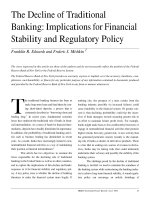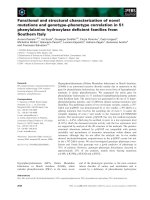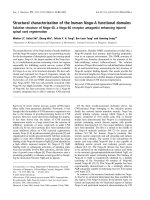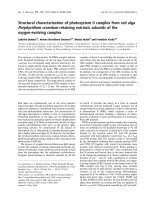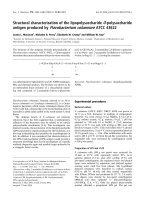Structural characterization of nogo proteins implications for biological functions and moleculedesign of therapeutic applications
Bạn đang xem bản rút gọn của tài liệu. Xem và tải ngay bản đầy đủ của tài liệu tại đây (3.38 MB, 189 trang )
STRUCTURAL CHARACTERIZATION OF NOGO PROTEINS:
IMPLICATIONS FOR BIOLOGICAL FUNCTIONS AND
MOLECULE DESIGN OF THERAPEUTIC APPLICATION
Li Minfen (B.Sc)
A THESIS SUBMITTED
FOR THE DEGREE OF DOCTOR OF PHILOSOPHY
DEPARTMENT OF BIOLOGICAL SCIENCES
NATIONAL UNIVERSITY OF SINGAPORE
2007
I
Acknowledgements
There are lots of people I would like to thank for a lot of reasons.
Firstly, I would like to express my deep and sincere gratitude to my supervisor, Dr.
Song Jianxing. I am grateful to him for his scientific emotional support. His
enthusiasm and integral view on research have made a deep impression on me. His
patience and consideration made me work comfortably in the lab during these years.
Secondly, my thank goes to all my labmates for their valuable advice and
friendly help , including Jiahai Shi, Weizheng, Jingxian Liu, Xiaoyuan Ruan and
Haina Qing. In particular, I am grateful to Dr Jingsong Fan for NMR experiment
training and collecting NMR spectra on the 800 MHz and 500MHz spectrometer. In
addion, I appreciate Associate Professor Xiao Zhicheng and his graduate Li Yali. They
gave me a great help for the neurite outgrowth experiments.
Thirdly, I also want to thank all my friends. Their valuable friendship gave me
energy to overcome the difficulty and let me never feel lonely.
Especially, I would like to pay tribute to the constant support of my family.
Without their love over these years, nothing would have been possible.
Lastly, I am grateful to National University of Singapore for providing me a
research scholarship, which enabled me to complete my PhD degree without financal
worry in Singapore.
II
TABLE OF CONTENTS
ACKNOWLEDGEMENTS I
TABLE OF CONTENTS II
SUMMARY VIII
LIST OF TABLES X
LIST OF FIGURES XI
LIST OF SYMBOLS XIII
CHAPTER I. INTRODUCTION 1
1.1. Biological Background 2
1.1.1. Axonal Regeneration 2
1.1.2 . Mechanisms Underlying the Inhibition of Axonal Regeneration in CNS 3
1.1.2.1. Lack of intrinsic regenerative ability 3
1.1.2.2. Lack of neurotrophic molecules 4
1.1.2.3. Inhibitory molecules in the CNS 5
1.1.2.3.1. Mag 5
1.1.2.3.2. Omagp 6
1.1.2.3.3. Nogo 6
III
1.1.2.3.4. Nogo receptor complex for Myelin-associated
inhibitory molecules 10
1.1.2.3.5. Strategies to block myelin inhibitory molecules effects 13
1.1.3. Biological Function Diversity of Nogos 16
1.1.3.1. Nogo in Apoptosis 16
1.1.3.2 . Nogo in ALS 17
1.1.3.3. Regulating K+ channel localization at CNS paranodes 18
1.1.3.4. Nogo in Multiple sclerosis (MS) 18
1.1.3.5. Nogo in Alzheimer’s disease 19
1.1.3.6. Vascular remodeling 20
1.1.3.7. A new physiological substrate for MAPKAP-K2 20
1.1.3.8. Endoplasmic reticulum tubule formation 21
1.2 . Intrinsically Disordered Protein 23
1.2.1. Reappraisal of the Protein Structure–Function Paradigm 23
1.2.2. Characterizations of Intrinsically Disordered Proteins 24
1.2.3. Biological Function of Intrinsically Disordered Proteins 25
1.2.4. Methods to Characterize Intrinsically Disorder Protein 25
1.2.4.1. Bioinformatics analysis 25
1.2.4.2. Experimental methods 26
1.3. Protein Structure Determination by NMR 29
1.3.1. Unique Features of NMR 29
IV
1.3.2. NMR Phenomenon 30
1.3.3. Chemical Shift 31
1.3.4. J Coupling 31
1.3.5. Nuclear Overhauser Effect (NOE) 34
1.3.6. NMR Relaxation Parameters 35
1.3.7. General Strategies of NMR Structure Determination 36
1.3.7.1. Protein sample preparation 36
1.3.7.2. NMR spectroscopy 38
1.3.7.3. Resonance assignment 38
1.3.7.4. Collection of conformational constraints 40
1.3.7.5. Calculation of the 3D structure 40
1.3.7.6. Evaluation of structure quality 41
1.4 Aims 42
CHAPTER II. MATERIALS AND METHODS 44
2.1. Vector Construction 45
2.2. Preparation of Competent E.coli Cells 45
2.3. Transformation of E. coli Cells 46
2.4. Protein Expression and Purification 46
2.5. Preparation of Isotope Labeled Proteins 47
2.6. Protein Analysis by SDS-PAGE 47
2.7. Determination of Protein Concentration by Spectroscopy 48
V
2.8. Circular Dichrosim (CD) spectroscopy 48
2.9. Isothermal Calorimetry (ITC) 48
2.10. Fluorescence 49
2.11. NMR Sample Preparation and Experiments 49
2.12. NMR Structure Determination 50
2.13. HSQC Characterization of the Binding between the SH3 Domains
with Nogo-A Fragments 51
CHAPTER III. RESULTS AND DISCUSSIONS 53
3.1. Structural Characterization of Inhibitory Domains of Nogo 54
3.1.1. Expression and structural characterization of NogoA-(567-748)
and Nogo-66 55
3.1.2. CD and NMR characterization of Nogo-40 60
3.1.3. NMR structure determination of Nogo-40 66
3.1.4. Discussion 73
3.2. Solution Structure of Nogo-60 and Design of Structured and
Active Nogo-54 76
3.2.1. Preliminary structural characterization 77
3.2.2. Structure and
15
N backbone dynamics of Nogo-60 78
3.2.3. Design of structured and active Nogo-54 85
3.2.4. Discussion 91
VI
3.3. Structural Characterization of Nogo-B and Systematic Dissection
of the Am-Nogo-A 92
3.3.1. Bioinformatics analysis 93
3.3.2. CD and NMR characterization of N- and C-termini of Nogo-B 97
3.3.3. CD and NMR characterization of the dissected Nogo-A fragments 100
3.3.4. Discussion 107
3.4. Identification of the Specific Molecular Interaction between the Nogo
and Nck2 Proteins 110
3.4.1. NMR and ITC characterization of the binding between the hNck2
SH3 domains and Nogo-A fragments 111
3.4.2. Identification of the Binding residues involved in the interaction
between the third hNck2 SH3 Domain and Nogo-A Peptide 116
3.4.3. Discussion 118
3.5. CD and NMR Studies of Protein Fragments Solubilized in Salt-Free Water
122
3.5.1. Nogo-66 fragments 123
3.5.2. Extracellular receptor (NgR) domains 126
3.5.3. Other proteins 127
3.5.4. Discussion 129
3.6. Structural Characterization of NgBR 134
3.6.1. Cloning and expression of NgBR and its dissected domains 136
3.6.2. Bioinformatics characterization 138
3.6.3. Structural characterization of the NgBR ectodomain 138
VII
3.6.4. Structural characterization of NgBR and its cytoplasmic domain 141
3.6.5. Disscussion 144
CHAPTER IV. CONCLUTION AND FURTHER WORK 147
REFERENCES 151
Appendix I Analysis of globularity and disordered regions of Nogo proteins 164
Appendix II alignment of human RTNs 169
Appendix III Publications 173
VIII
SUMMARY
Nogo-A, the largest isoform of RTN4/Nogo, was originally identified as an
inhibitor of neurite outgrowth of the central nervous system (CNS) and has received
intensive studies. In addition, more and more novel functions have been recently
found to be associated with Nogo molecules, including vascular remodeling, apoptosis,
interaction with β-amyloid protein converting enzyme, formation/maintenance of the
tubular network of the endoplasmic reticulum (ER), and so on. In order to understand
the structure-function relationship of Nogo molecules, we initiated a systematical
investigation of structural properties of Nogo molecules by a combined use of
bioinformatics analysis, and biochemical and biophysical approaches.
Firstly, two identified inhibitory domains (Ngogo-A_567-748 and Nogo-66) had
been studies. CD and NMR characterization indicated that Ngogo-A_567-748 was
partially structured while Nogo-66 was highly insoluble. Therefore, we targeted at
buffer-soluble Nogo-40, which is a truncated form of Nogo-66 and was demonstrated
as an NgR antagonist. Nogo-40 was flexible in the phosphate buffer while in presence
of TFE Nogo-40 revealed two well-defined helices linked by an unstructured loop.
The surprising discovery that buffer-insoluble protein domains could be easily
solubilized in salt-free water allowed us to go back to determine the structure of Nogo-
60 in water. Nogo-60 adopted a structure with the N- and C-terminal helices
connected by a long middle helix and it appeared that the packing between the C-helix
and the 20-residue middle helix triggered the formation of the stable Nogo-60
structure. Based on Nogo-60 structure, a structured and buffer-soluble Nogo-54 was
successfully designed, which may hold promising potential to be used as a novel NgR
IX
antagonist to enhance CNS axonal regeneration. We further extended the structural
study to the full-length of NogoA/B. Except for the helical loop of Nogo-66 and C-
terminal transmembrane domains, NogoA/B were predominantly unstructured in
solution. We speculated that being intrinsically unstructured may allow Nogo
molecules to serve as double-faceted functional players, with one set of functions
involved in cellular signaling processes essential for CNS neuronal regeneration,
vascular remodeling, apoptosis and so forth; and with another in
generating/maintaining membrane-related structures.
Interestingly, proline rich N-terminus of Nogo-A/B possesses many short
binding motifs. With the assistance of NMR spectroscopy and ITC, for the first time
we identified a tight and specific binding between Nogo-A (171-181) and the third
Nck2 SH3 domain with a Kd of 2.8 µM , which provides a novel clue for the
investigation of the Nogo functions and its cross-talks with other Nck2-coordinated
signaling networks such as Eph-ephrinB signaling.
In addition, we characterized the structural properties of 297-residue Nogo B
receptor (NgBR). Our results indicate that the NgBR ectodomain is intrinsically
unstructured without both secondary and tertiary structures while the cytoplasmic
domain is only partially folded with secondary structures but without a tight tertiary
packing.
In summary, this project leads to the establishment of a complete structural
picture about Nogo proteins, which would not only facilitate the understanding of the
mechanism of the diverse functions of Nogos, but also may have implications in drug
design for human diseases associated with Nogos.
X
List of Tables
Table 1.1. Summary of the main therapeutic approaches currently used to promote
axonal regeneration. 15
Table 3.1.1. Chemical shifts of Nogo-24 in 25 mM phosphate buffer (pH6.8) at 298K
63
Table 3.1.2. Chemical shifts of Nogo-40 in 50/50 % (TFE/H
2
O) mixture at 308K 67
Table 3.1.3. NMR restrains used for structure calculation and structure statistics for
the 10 selected lowest-energy structures of Nogo-40 71
Table 3.2.1. Chemical shifts of Nogo-60 in a 90/10 % (H
2
O/D
2
O) 81
Table 3.2.2. NMR constraints and structural statistics for the 20 accepted CYANA
structures of Nogo-60 83
Table3.2.3. NMR constraints and structural statistics for the 20 accepted CYANA
structures of Nogo-54 88
Table3.4.1. Binding interaction between the human Nogo-A fragments and hNck2
SH3 domain monitored by NMR and ITC 113
Table 3.4.2.Thermodynamic parameters of the binding interaction between Nogo-A
peptides and the third hNck2 SH3 domain measured by ITC at 25 ℃ 115
XI
List of Figures
Figure 1.1. The three transcripts from the RTN4 and membrane topologies and
subcellular localization of Nogo/RTN4. 9
Figure 1.2. Molecular basis of Nogo-A mediated neurite outgrowth inhibition 12
Figure 1.3. Chemical shift deviations of Hα, Cα, Cβ from random coil values 32
Figure 1.4. NOE patterns associated with secondary structure 33
Figure 1.5. Strategy of structure determination by NMR 37
Figure 1.6. Outline of structure calculation by NMR. 39
Figure 3.1.1. Schematic representation of the domain organization of the human
Nogo-A protein 56
Figure 3.1.2. Expression and purification of Nogo-A-(567-748) and Nogo-66 57
Figure 3.1.3. CD and NMR characterization of NogoA-(567-748) 59
Figure 3.1.4. Secondary structural prediction of Nogo-40 by DNAMAN 61
Figure 3.1.5. NMR characterization of Nogo-24 64
Figure 3.1.6. CD and NMR characterization of Nogo-40 65
Figure 3.1.7. NMR spectral assignment of Nogo-40 68
Figure 3.1.8. secondary structures of Nogo-24 and Nogo-40 69
Figure 3.1.9. Solution structure of Nogo-40 72
Figure 3.2.1. CD and NMR characterization of Nogo peptides 79
Figure 3.2.2. The NOE patterns critical for defining the secondary structure of
Nogo-60 in the salt-free water (pH 4.0) at 278 K. 80
Figure 3.2.3. Solution structure of Nogo-60 84
Figure 3.2.4.
15
N NMR backbone dynamics. 86
Figure 3.2.5. Solution structure of Nogo-54. 87
XII
Figure 3.2.6. Neurite outgrowth assay of Nogo-54 90
Figure 3.3.1. The domain organization and dissection of the human Nogo proteins
94
Figure 3.3.2. Analysis of globularity and disordered regions of Nogo proteins 95
Figure 3.3.3. Functional sites prediction of Nogo-B by ELM 96
Figure 3.3.4. CD and NMR characterization of the Nogo-B N-terminus 99
Figure 3.3.5. CD and NMR characterization of the Nogo-33 101
Figure 3.3.6. CD and NMR characterization of the first group of the dissected
Nogo-A Fragments 103
Figure 3.3.7. CD and NMR characterization of the second group of the dissected
Nogo-A fragments 104
Figure 3.3.8. CD and NMR characterization of the mixture of nine dissected Nogo-A
fragments P0-P9 105
Figure 3.4.1. ITC characterization of the binding interaction between the third hNck2
SH3 domain and Nogo-A fragments 114
Figure 3.4.2. NMR structures of the third hNck2 SH3 domain 117
Figure 3.4.3. The interaction between the third hNck2 SH3 domain and the proline-
rich motifs located at the N-terminus of Nogo-A 119
Figure 3.5.1. CD and HSQC characterization of Nogo-66 fragments 124
Figure 3.5.2. Conformational properties of Nogo-54 125
Figure3.5.3. CD and HSQC characterization of extracellular domains of
transmembrane receptors 128
Figure 3.6.1. Domain organization of NgBR and its expression and purification 137
Figure 3.6.2. Bioinformatics analysis of NgBR. 139
Figure 3.6.3. CD and NMR characterization of the NgBR ectodomain 140
Figure 3.6.4. CD and NMR characterization of the full-length NgBR and its
cytoplamic domain 143
XIII
Symbols and Abbreviations
I Spin Number
γ Gyromagnetic Ratio
δ Chemical Shift
ΔCα Cα Conformational Shifts
1
J/
2
J /
3
J Scalar Coupling Through One Bond/ Two bonds/
Three bonds
d
αN
/ d
βN
/ d
NN
NOE Connectivity Between CαH/ CβH/ NH with NH
(θ)
MRW
Mean Molar Ellipticity per Residue in CD
CD Circular Dichroism
CNS Central Nervous system
DTT Dithiothreitol
E.coli Escherichia coli
FID Free induction decay
GST Gluthathione S-transferase
HSQC Heteronuclear Single Quantum Coherence
IPTG Isopropyl β-D-thiogalactopyranoside
LB Luria Bertani
MALDI-TOF
MS
Matrix-Assisted Laser Desorption/Ionization Time-of-
flight Mass Spectroscopy
XIV
NMR Nuclear Magnetic Resonance
NOE Nuclear Overhauser Enhancement
NOESY Nuclear Overhauser Enhancement Spectroscopy
OD Optical Density
PBS Phosphate-buffered Saline
PCR Polymerase Chain Reaction
ppm Part Per Million
RMSD Root Mean-square Deviation
(RP-)HPLC (Reversed-Phase) High Performance Liquid
Chromatography
SDS-PAGE Sodium Dodecyl Sulphate Polyacrylamide Gel
Electrophoresis
TOCSY Total Correlation Spectroscopy
UV Ultraviolet
1
CHAPTER I. INTRODUCTION
2
Chapter I. INTRODUCTION
1.1 . Biological Background
1.1.1. Axonal Regeneration
CNS (central nervous system) injuries, such as spinal cord injury, traumatic
brain injury and stroke, are characterized by the failure of regeneration of the
transected axons. Each year in the United States, more than 2 million people suffer
from traumatic brain injuries, over 500,000 people suffer from stroke, and at least
10,000 people suffer from spinal cord injuries. So far, the primary treatments are based
on physical therapy and it is estimated that only 0.9 % of the patients will have
completed neurological recovery. Therefore, there is a huge unmet medical need for
treating CNS injury (Daniel et al., 2003). Understanding why the injured axon cannot
regenerate in CNS is fundamental to the development of medical therapy.
Unlike fish, amphibian, the mammalian peripheral nerves and developing
central nerves, the adult central mammalian neurons fail to regenerate after injury. The
consequences are not only interrupting the communication between healthy neurons,
but also leading to neuronal degeneration and cell death (Philip et al., 2000). In the
particularly favorable conditions, neuron in the adult CNS can regenerate. However,
the regeneration rate of adult neuron is much slower than the elongation rate observed
for the same neuron during the embryonic stages and this decrease in the ability of
regeneration, parallel to neuronal maturation, also occurs in peripheral nerves system
(PNS) (Condic, 2002).
3
1.1.2. Mechanisms underlying the failure of axonal regeneration in CNS
To achieve the success of axonal regeneration, a number of conditions must be
fulfilled. The primary is the survival of neuronal soma. Whereafter, the injured axon
should be able to re-form a new growth cone to reach its original target and make
synapsis with it. Finally, the new connection has to be re-myelinated. Over the past
several decades, the mechanism underlying the failure of regeneration of injured axons
in CNS has been extensively investigated; however, the exact reasons are still not clear.
Three broad categories of the hypotheses seek to explain this phenomenon: CNS
neurons may lack sufficient intrinsic regenerative ability to allow prolonged axonal
regeneration; the CNS may lack adequate supplies of neurotrophic molecules to
support regenerating axons; and there may be inhibitory molecules in the CNS that
block axonal regeneration (HUNT et al., 2003).
1.1.2.1. Lack of intrinsic regenerative ability
Some intracellular changes responsible for the loss of the intrinsic ability of
regeneration are identified. One critical change is the decrease of the expression levels
of growth-promoting molecules in CNS, such as GAP-43 and CAP23 (Rossi et al.,
2001); while the expression levels of receptors for neurite outgrowth inhibitory
molecules (such as NgR) increase after certain stages of development in CNS
(Halabiah et al., 2005). Cyclic nucleotide levels also have observable changes. During
neuronal development, high concentration of cAMP promotes axonal outgrowth
through inactivation of Rho GTPase. However, after a particular point of the
4
development, the concentration of cAMP drops rapidly, which not only reduces the
intrinsic ability of the neuron regeneration, but also increases growth cone’s sensitivity
to axonal outgrowth inhibitory molecules (Cai et al., 2001).
1.1.2.2. Lack of neurotrophic molecules
Neurotrophins, secreted by cells in a neuron's target field, encourage survival of
nervous tissue. Neurotrophins family includes nerve growth factor (NGF), brain-
derived neurotrophic factor (BDNF), neurotrophin 3 (NT-3), and neurotrophin 4 (NT-4)
(Korsching 1993). Neurotrophins interact with two classes of receptors, p75 and the
Tyrosine kinases. p75 can bind with almost all of the neurotrophins with low affinity;
while the Tyrosine kinases only bind with specific neurotrophins but with a much
higher affinity (Chao et al., 1995). The interaction between neurotrophin with its
receptor results in cascades of signal transduction events that coordinate changes in
cellular cytoskeleton and then in turn mediate the growth process. Many studies
confirm the neurotrophins’ effect of both cell survival and axon growth-promoting
after the injury to the adult CNS in vivo (
Cui , 2006).
Out of over 30 neurotrophic factors, six of them have been investigated as
potential treatments for lesioned spinal cords in animal models. However, the clinic
usage of neurotrophic factors is limited by the delivery problems and side effects. For
example, although nerve growth factor (NGF) has the positive regenerative effects on
peripheral nerves, it turned out to be clinically useless due to its effect of increasing
sensitivity to pain (Schwab, 2002).
5
1.1.2.3. Inhibitory molecules in the CNS
The lack of CNS regeneration was not only due to the absence of growth-
promoting factors in CNS neurons but also due to the presence of inhibitory molecules
in CNS. This hypothesis has dominated during the past decades and leads to extensive
investigation. The identified inhibitory molecules include the chondroitin sulfate
proteoglycans (CSPG) Neurocan, Brevican, Phosphacan, Tenascin, and NG2, as either
membrane-bound or secreted molecules; Ephrins expressed on astrocyte /fibroblast
membranes; membrane-bound semaphorins (Sema) produced by meningeal fibroblasts
invading the scar; and the myelin-associated inhibitors Nogo, MAG, and OMgp
(Sandvig et al., 2004). Here we will particularly introduce the three myelin-associated
inhibitory molecules, including the molecular structure, cellular location and the
function related to the neurite outgrowth in CNS.
1.1.2.3.1. MAG
Myelin-associated glycolprotein (MAG), the first myelin-associated protein to
be characterized as an inhibitor of axon outgrowth, is expressed by oligodendrocytes
and Schwann cells in central and peripheral myelin respectively (McKerracher et al.,
1994; Mukhopadhyay et al., 1994; and Filbin, 1995). As a member of the
Immunoglobulin Superfamily, MAG contains five Ig domains, a transmembrane
domain and a short intracellular domain (Tropak et al., 1988). The primary sequences
of MAG intracellular domain share no significantly homology with other proteins. The
inhibitory effect of MAG in vitro is restricted to adult neurons, whereas in embryonic
neurons MAG promotes neurons outgrowth. The dual nature of MAG activity is
6
regulated by intracellular cAMP levels (Cai et al., 2001).However, MAG knockout
mice display little difference in terms of the regenerative ability of damaged spinal
axons compared to wild-type mice (Bartsch et al., 1995). The role of MAG in
neuronal regeneration in vivo has yet to be explored.
1.1.2.3.2. Omagp
Although identified in 1988 (Mikol et al., 1988), OMgp is the least known
molecule of the three myelin-associated inhibitors (Kottis et al., 2002; Wang et al.,
2002). Omagp is expressed by oligodendrocyte myelin and neurons. The mature
OMgp consists of 401 aas, formed by four domains: one cystein-rich N-terminal
domain, a leucine-rich repeat (LRR) domain, a serine-threonine rich domain, and a
gycosyphosphatidylinositol (GPI)-link on its C-terminus. Through the GPI linkage,
OMgp is localized to the outer leaflet of the plasma membrane. The experiments in
vitro have shown that OMgp causes growth cone collapse and inhibits neurite
outgrowth (Grados-Munro et al., 2003). The function of OMgp in vivo remains to be
studied.
1.1.2.3.3. Nogo (RTN4)
The most widely studied myelin-associated inhibitor is Nogo (Chen et al.,
2000; GrandPre et al., 2000; Prinjha et al., 2000). Nogo (RTN4) is a member of the
reticulon family. Reticulons (RTNs) are a relatively new eukaryotic gene family with
ubiquitous expression and distinctive topological features (Figure 1.1b) (Oertle et al.,
2003). With the discovery of the first member RTN1, more than 300 family members
7
have been found in a variety of organisms (Oertle et al., 2003). In mammalian
genomes four different reticulon genes RTN1, RTN2, RTN3 and RTN4/Nogos are
identified. These genes encode a large number of isoforms that share homologies
within the C-terminal region of 200 amino acids, called the reticulon-homology
domain (RHD). Although widely distributed, the functions of RTNs are still poorly
understood. Most interests have been focus on RTN4/Nogo due to their involvement in
various critical biological processed and association with the pathogenesis of human
disease, especially the inhibition effect in CNS neuron regeneration.
RTN4/Nogo (on human chromosomal 2p14-p13) gene generate three different
isoforms, termed Nogo-A, -B and –C, by alternative promoter usage and /or splicing.
Nogo-A, -B and –C proteins and mRNAs are expressed ubiquitously, although there is
some tissue specificity. For example, NogoA is mainly expressed in brain and heart;
NogoB is widespread on distribution; whereas NogoC is particularly abundant in
muscle cells (Oertle et al., 2003). As a member of RTNs, RTN4/Nogo proteins share a
conserved C-terminal domain of 188 amino acids, consisting of two potentially
membrane-spanning hydrophobic domains separated by a hydrophilic fragment of 66
amino acids termed Nogo-66, followed by a 38-residue C-tail carrying endoplasmic
reticulum (ER) retention motif. Accordingly, the majority of the Nogo proteins are
localized to ER, with a small amount on the cell surface (Oertle et al., 2003). The N-
terminal regions of RTN4/Nogos are highly variable (Figure 1.1a). The 1192-residue
Nogo-A is the largest isoform with an ~1016-residue N-terminus while the 373-
residue Nogo-B owns a N-terminus almost identical to the first 200 residues of Nogo-
A. The smallest variant Nogo-C consisting of 199 residues is made up of a very short
8
N-terminus plus the reticulon-homology domain (RHD) (Oertle et al., 2003).
Significant progresses have been made in identifying the inhibitory regions of
Nogo-A. So far at least two main regions responsible for the neurite-growth-inhibiting
effect have been identified: The first is a stretch in the middle of the unique N-
terminus of Nogo-A molecule (residues 544-725 for mouse and residues 567-748 for
human Nogo-A proteins). The receptor for this inhibitory domain is still unclear. The
other is the extracellular 66 amino acid loop termed Nogo-66. Nogo-66 domain binds
to the neuronal glycophosphatidylinositol (GPI)-linked NgR, via its leucine-rich repeat
containing domain (Fournier et al., 2001).
Nogos-knockout mice have been intensively studied. Unexpectedly the results
from three independent groups are not consistent. Kim’s group showed that the mutant
lines lacking Nogo-A and –B displayed enhanced axonal regeneration after CST lesion
accompanied by functional recovery (Kim et al., 2003); while the results from
Simonen group were much more modest (Simonen et al., 2003). Moreover, Zheng’s
group showed that mutant lines lacking Nogo-A, -B and –C display little enhanced
axonal regeneration (Zheng et al., 2003). Currently, we cannot provide a convincing
explanation for this divergence and this divergence has evidenced the need of further
investigation about Nogos on axonal regeneration failure.
9
(a)
(b)
Figure 1.1. Three transcripts from the RTN4 and membrane topologies and
subcellular localization of Nogo/RTN4. (a) The common C-terminus encodes the
reticulon-homology domain (RHD), whereas the N-termini are specific for each
isoform and have no obvious sequence homologies to other proteins. (b) Two
proposed topologies for Nogo/RTN4. The lengths of the hydrophobic stretches (about
35 amino acids) could allow them to span the membrane once or twice (Adapted from
Oertle et al., 2003).
Nogo-A-specific region Nogo-66
RTN4-A/NogoA
RTN4-B/NogoB
RTN4-C/NogoC
Extracell/ER lumen
Cytopl
Extracell/ER lumen
Cytopl
T
M
T
M
C
T
M
T
M
C
N
T
M
T
M
N
N
C
10
1.1.2.3.4. Nogo receptor complex for Myelin-associated Inhibitory molecules
As Myelin-associated inhibitory proteins in CNS myelin have been demonstrated
to play a role in axon regeneration following CNS injury, the identification of the
receptor for these ligands is a crucial link in the molecular pathway. In 2001, this link
— the Nogo-66 receptor (NgR, now also termed NgR1) — was identified (Fournier,
2001). Not only does NgR bind to Nogo-66 with high affinity, but also it exhibits an
expression pattern consistent with a role in CNS axonal regeneration. NgR is only
expressed by the adult neurons while not by the early embryonic neurons. Interestingly,
NgR also appears to be a functional receptor for MAG and OMgp. It seems that MAG,
Nogo-66 and OMgp share the same binding sites on NgR and mediate their effects
through the same pathways (Figure 1.2). Therefore, NgR is a focal point for the
convergence of three myelin inhibitors (Barton et al., 2003).
NgR is a 473 amino acid protein containing a signal sequence, a leucine-rich
repeat (LRR)-type N-terminal domain(LRRNT), eight LRR domains, a cysteine-rich
LRR-type C-terminal flanking domain (LRRCT), a unique C-terminal region, and a
GPI anchorage site. Homologous proteins to NgR have now been identified as NgR2
or NgRH1 (human 420 aa) and NgR3 or NgRH2 (human 441 aa) (Piqnot et al., 2003).
There is about 50 % sequence homology between the NgR1-3. Both NgR2 and NgR3
are expressed in the brain. Significant level of NgR2 expression is detected in the liver.
Other peripheral tissues also show some level of NgR2. Despite the similarity in
sequence and protein topology, NgR2 and NgR3 do not bind Nogo and Omgp. NgR2
is identified as a novel receptor for MAG and acts selectively to mediate MAG
inhibitory responses (Venkatesh et al., 2005). The identity of natural ligands for NgR3
